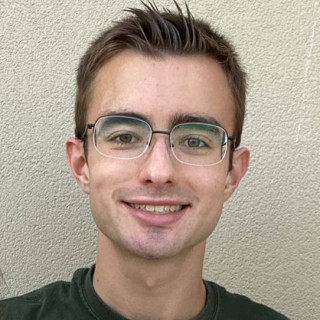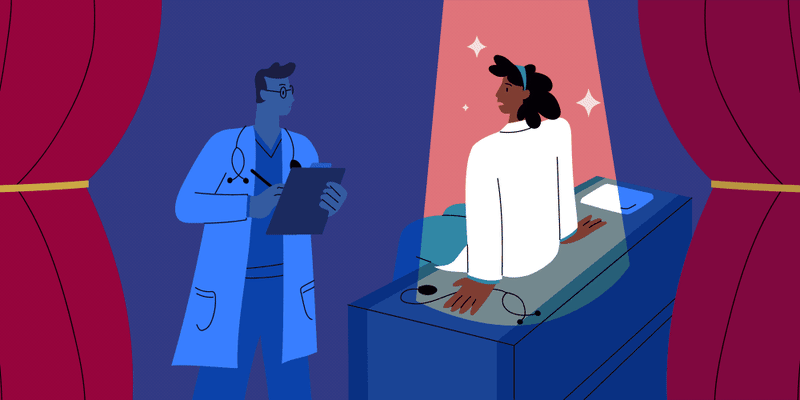“Jessica, hello! How are you doing today?”
Jessica wasn’t real. She was a standardized patient, a fictional character created by my medical school for training purposes. After entering the clinical wards, I quickly drew this distinction between reality and “make believe.” With Jessica, I could make mistakes. I could flub my words, pause the interview, say something insensitive, or forget to ask a pertinent aspect of patient history with no real recourse. I shut the door behind me and entered the simulation.
“I have burning in my vagina.”
She spoke quietly and with a flat affect, and I was quick to adjust my voice to match hers. This week, our simulation involved human trafficking of a minor. First, we were tasked with forming a patient-doctor relationship and determining the pathology behind our patient’s pelvic pain. Then, after establishing a foundation of trust, we were asked to assess our patient’s willingness to leave her abuser. The total time allotted with our patient: 15 minutes.
“Well, that’s no good. Tell me, when did this start?”
I leaned in and composed a look of concern beneath my mask. Navigating patient interactions was a skill I had yet to master. Early eye contact, leaning in, and name repetition seemed to work well during my first few weeks on the wards. But every patient was different, and I hadn’t learned all the subtle cues to guide my behavior. Furthermore, the artificial nature of this interaction added yet another layer to be traversed.
I moved quickly to obtain the pertinent history. Vaginal discharge, fever, difficulty walking, a one-week duration. Textbook symptoms for pelvic inflammatory disease, a diagnosis my preceptor hinted toward in the hour leading up to my simulation. I finished asking about her symptoms and looked at the clock. Seven minutes left, and I had yet to triage the severity of her sexual abuse.
“Jessica, we’re on the same team. This might be an infection. Would you be able to tell me about your sexual activity?”
Our conversation went back and forth. She initially rejected the premise of my question, questioning its relevance. Then, after gentle encouragement, she began disclosing unwanted past sexual contact with over 10 men over the past year. I nodded and listened.
“I see. Why do you have all these sexual contacts if you have a boyfriend?”
The words left my mouth before I could filter them. Much too judgmental, I thought. I looked over to the clock: two minutes left.
“My boyfriend is waiting. I really need to go.”
“Wait, Jessica, before you go I need you to know your options."
“I don’t have options. I must go.”
“Wait, please, it's my job to help you. We can always go to the authorities.”
“No, I don’t want to do that. Give me the medication so I can go.”
I nodded, told her I understood, and obliged her request. The interaction ended, and the feedback I received from my preceptor and the standardized patient was relatively positive: I had established a good patient-doctor relationship within the 15-minute period. I had encouraged the patient to open up to me, and I had successfully diagnosed pelvic inflammatory disease. My preceptor was satisfied with the interaction, and yet I had let my patient walk away without successfully solving her underlying problem.
With the sense of defeat still lingering, I entered the session debrief room along with roughly 10 other students. During the next 30 minutes, a faculty member spoke about the complexities of human trafficking and the limited role physicians have in preventing and reporting potential sex crimes. The desire to help the patient must be tempered by an understanding of reality, no matter how uncomfortable this reality may be.
My medical school experience continues to be the most challenging chapter of my adult life. Repetitive test taking, frequent faculty evaluations, and challenging patient interactions are constant reminders that I may lack the defining characteristics of a “good” doctor. So often the Liaison Committee on Medical Education curriculum dictates objectively correct and incorrect answers. With Jessica, there wasn’t a correct answer. The 15-minute visit had transcended the expectations I had of my own school’s curriculum.
Medical schools are confronted with significant dilemmas when structuring curricula. Every standardized patient interaction must be planned out, and each must match a student’s skill level. In the quest for objective evaluations of students, it's all too easy to create a simulation with a textbook diagnosis and treatment plan. Students either successfully diagnose the patient or miss the mark. This aspect of medical education is undoubtedly an important one. Objective evaluations produce knowledgeable doctors, and good doctors must be knowledgeable.
Yet, paradoxically, I learned more from my experience with Jessica than in any other simulation. In the past four months, there were numerous times when I left a patient’s room feeling defeated. Being unable to help, due to unique psychosocial situations or disease pathologies, is an aspect of medicine that students are shielded from until they enter “the real world.” The patient with metastatic ovarian cancer, the patient with systolic heart failure, and the patient with an irreversible cognitive impairment all still look to us for help, even when there is only so much help we can provide. Introducing this aspect of medicine early in medical education can better prepare graduates for difficult real-world conversations. For me, it was my experience with real patients that helped temper my expectations with Jessica. I just wish it would have been the other way around.
Have you had an experience with a patient you knew you could not save? Share in the comments.
Lachlan is a second-year medical student attending the USF Morsani College of Medicine. His interests include neurological research, medical humanities, and running.
Image by Alphavector / Shutterstock







